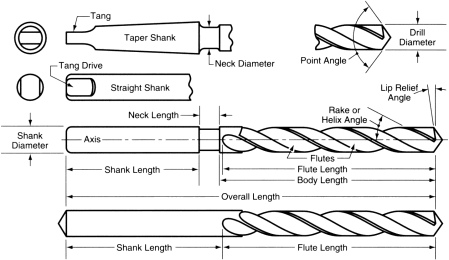Technical Data
Drills Glossary of Terms

DRILL - A rotary end cutting tool having one or more cutting lips and having one or more helical or straight flutes for the passage of chips and the admission of a cutting fluid.
AXIS - The imaginary straight line which forms the longitudinal center line of the drill.
BACK TAPER - A slight decrease in diameter from point to back in the body of the drill.
BODY - The portion of the drill extending from the shank or neck to the outer corners of the cutting lips.
BODY DIAMETER CLEARANCE - That portion of the land that has been cut away so it will not rub against the walls of the hole.
CHISEL EDGE - The edge at the end of the web that connects the cutting lips.
CHISEL EDGE ANGLE - The angle included between the chisel edge and the cutting lip, as viewed from the end of the drill.
CLEARANCE DIAMETER - The diameter over the cut away portion of the drill lands.
DRILL DIAMETER - The diameter over the margins of the drill measured at the point.
FLUTES - Helical or straight grooves cut or formed in the body of the drill to provide cutting lips, to permit removal of chips, and to allow cutting fluid to reach the cutting lips.
FLUTE LENGTH - The length from the outer corners of the cutting lips to the extreme back end of the flutes. It includes the sweep of the tool used to generate the flutes and, therefore, does not indicate the usable length of the flutes.
HELIX ANGLE - The angle made by the leading edge of the land with a plane containing the axis of the drill.
LAND - The peripheral portion of the body between adjacent flutes.
LAND WIDTH - The distance in a transverse plane between the leading edge and the heel of the land measured at a right angle to the leading edge.
LIPS - The cutting edges of a two flute drill extending from the chisel edqe to the periphery. (CORE DRILLS) - The cutting edges extending from the bottom of the chamfer to the periphery.
LIP RELIEF ANGLE - The axial relief angle at the outer corner of the lip. It is measured by projection into a plane tangent to the periphery at the outer corner of the lip.
MARGIN - The cylindrical portion of the land which is not cut away to provide clearance.
NECK - The section of reduced diameter between the body and the shank of a drill.
OVERALL LENGTH - The length from the extreme end of the shank to the outer corners of the cutting lips. It does not include the conical shank end often used on straight shank drills, nor does it include the conical cutting point used on both straight and taper shank drills.
PERIPHERAL RAKE ANGLE - The angle between the leading edge of the land and an axial plane at the drill point.
POINT - The cutting end of a drill, made up of the ends of the lands and the web. In form it resembles a cone, but departs from a true cone to furnish clearance behind the cutting lips.
POINT ANGLE - The angle included between the lips projected upon a plane parallel to the drill axis and parallel to the cutting lips.
SHANK - The part of the drill by which it is held and driven.
TANG - The flattened end of a taper shank, intended to fit into a driving slot in a socket.
TANG DRIVE - Two opposite parallel driving flats on the extreme end of a straight shank.
WEB -The central portion of the body that joins the lands. The extreme end of the web forms the chisel edge on a two-flute drill.
WEB THICKNESS - The thickness of the web at the point unless another specific location is indicated.
WEB THINNING - The operation of reducing the web thickness at the point to reduce drilling thrust.
